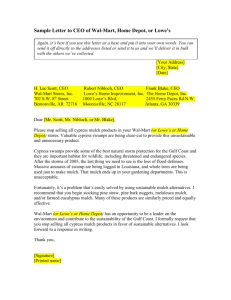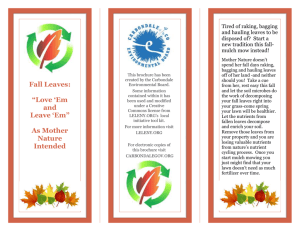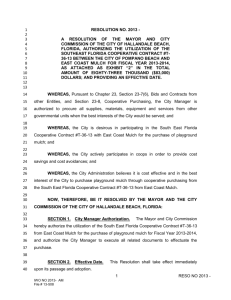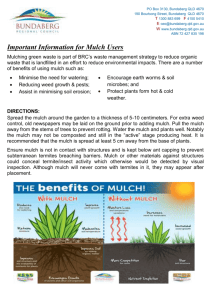Proper Mulching Techniques
advertisement
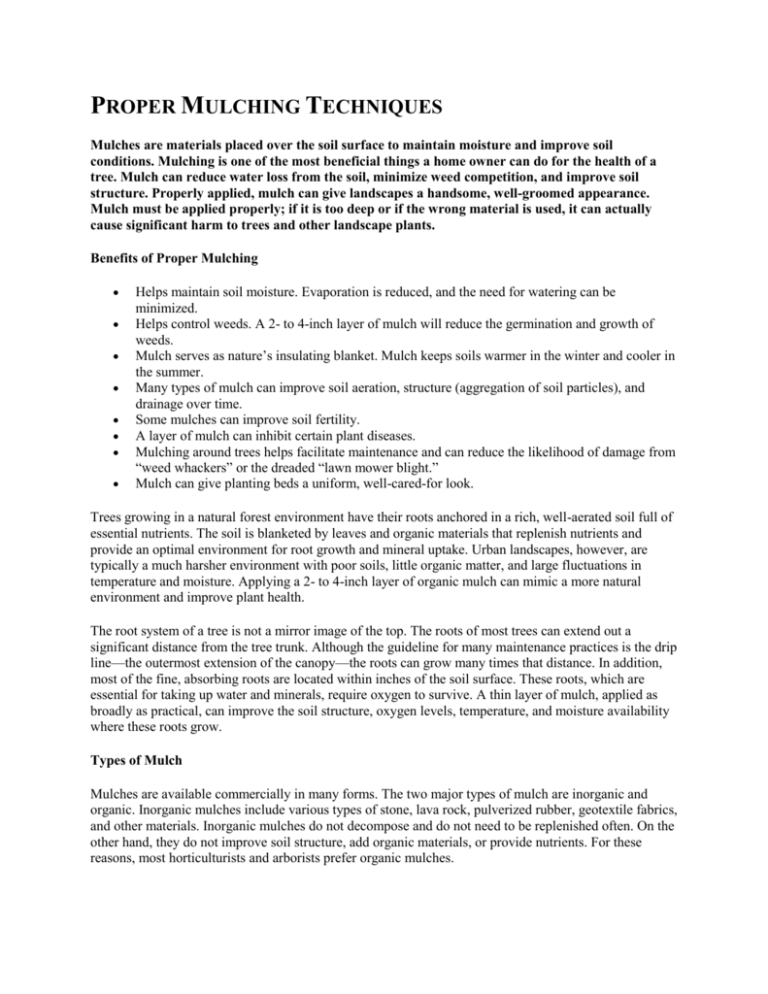
PROPER MULCHING TECHNIQUES Mulches are materials placed over the soil surface to maintain moisture and improve soil conditions. Mulching is one of the most beneficial things a home owner can do for the health of a tree. Mulch can reduce water loss from the soil, minimize weed competition, and improve soil structure. Properly applied, mulch can give landscapes a handsome, well-groomed appearance. Mulch must be applied properly; if it is too deep or if the wrong material is used, it can actually cause significant harm to trees and other landscape plants. Benefits of Proper Mulching Helps maintain soil moisture. Evaporation is reduced, and the need for watering can be minimized. Helps control weeds. A 2- to 4-inch layer of mulch will reduce the germination and growth of weeds. Mulch serves as nature’s insulating blanket. Mulch keeps soils warmer in the winter and cooler in the summer. Many types of mulch can improve soil aeration, structure (aggregation of soil particles), and drainage over time. Some mulches can improve soil fertility. A layer of mulch can inhibit certain plant diseases. Mulching around trees helps facilitate maintenance and can reduce the likelihood of damage from “weed whackers” or the dreaded “lawn mower blight.” Mulch can give planting beds a uniform, well-cared-for look. Trees growing in a natural forest environment have their roots anchored in a rich, well-aerated soil full of essential nutrients. The soil is blanketed by leaves and organic materials that replenish nutrients and provide an optimal environment for root growth and mineral uptake. Urban landscapes, however, are typically a much harsher environment with poor soils, little organic matter, and large fluctuations in temperature and moisture. Applying a 2- to 4-inch layer of organic mulch can mimic a more natural environment and improve plant health. The root system of a tree is not a mirror image of the top. The roots of most trees can extend out a significant distance from the tree trunk. Although the guideline for many maintenance practices is the drip line—the outermost extension of the canopy—the roots can grow many times that distance. In addition, most of the fine, absorbing roots are located within inches of the soil surface. These roots, which are essential for taking up water and minerals, require oxygen to survive. A thin layer of mulch, applied as broadly as practical, can improve the soil structure, oxygen levels, temperature, and moisture availability where these roots grow. Types of Mulch Mulches are available commercially in many forms. The two major types of mulch are inorganic and organic. Inorganic mulches include various types of stone, lava rock, pulverized rubber, geotextile fabrics, and other materials. Inorganic mulches do not decompose and do not need to be replenished often. On the other hand, they do not improve soil structure, add organic materials, or provide nutrients. For these reasons, most horticulturists and arborists prefer organic mulches. Organic mulches include wood chips, pine needles, hardwood and softwood bark, cocoa hulls, leaves, compost mixes, and a variety of other products usually derived from plants. Organic mulches decompose in the landscape at different rates depending on the material and climate. Those that decompose faster must be replenished more often. Because the decomposition process improves soil quality and fertility, many arborists and other landscape professionals consider that characteristic a positive one, despite the added maintenance. Not Too Much! As beneficial as mulch is, too much can be harmful. The generally recommended mulching depth is 2 to 4 inches. Unfortunately, many landscapes are falling victim to a plague of overmulching. A new term, “mulch volcanoes,” has emerged to describe mulch that has been piled up around the base of trees. Most organic mulches must be replenished, but the rate of decomposition varies. Some mulches, such as cypress mulch, remain intact for many years. Top dressing with new mulch annually (often for the sake of refreshing the color) creates a buildup to depths that can be unhealthy. Deep mulch can be effective in suppressing weeds and reducing maintenance, but it often causes additional problems. Problems Associated with Improper Mulching Deep mulch can lead to excess moisture in the root zone, which can stress the plant and cause root rot. Piling mulch against the trunk or stems of plants can stress stem tissues and may lead to insect and disease problems. Some mulches, especially those containing cut grass, can affect soil pH. Continued use of certain mulches over long periods can lead to micronutrient deficiencies or toxicities. Mulch piled high against the trunks of young trees may create habitats for rodents that chew the bark and can girdle the trees. Thick blankets of fine mulch can become matted and may prevent the penetration of water and air. In addition, a thick layer of fine mulch can become like potting soil and may support weed growth. Anaerobic “sour” mulch may give off pungent odors, and the alcohols and organic acids that build up may be toxic to young plants. Proper Mulching It is clear that the choice of mulch and the method of application can be important to the health of landscape plants. The following are some guidelines to use when applying mulch. Inspect plants and soil in the area to be mulched. Determine whether drainage is adequate. Determine whether there are plants that may be affected by the choice of mulch. Most commonly available mulches work well in most landscapes. Some plants may benefit from the use of a slightly acidifying mulch such as pine bark. If mulch is already present, check the depth. Do not add mulch if there is a sufficient layer in place. Rake the old mulch to break up any matted layers and to refresh the appearance. Some landscape maintenance companies spray mulch with a water-soluble, vegetable-based dye to improve the appearance. If mulch is piled against the stems or tree trunks, pull it back several inches so that the base of the trunk and the root crown are exposed. Organic mulches usually are preferred to inorganic materials due to their soil-enhancing properties. If organic mulch is used, it should be well aerated and, preferably, composted. Avoid sour-smelling mulch. Composted wood chips can make good mulch, especially when they contain a blend of leaves, bark, and wood. Fresh wood chips also may be used around established trees and shrubs. Avoid using noncomposted wood chips that have been piled deeply without exposure to oxygen. For well-drained sites, apply a 2- to 4-inch layer of mulch. If there are drainage problems, a thinner layer should be used. Avoid placing mulch against the tree trunks. Place mulch out to the tree’s drip line or beyond. Remember: If the tree had a say in the matter, its entire root system (which usually extends well beyond the drip line) would be mulched. E-mail inquiries: isa@isa-arbor.com (c) 1998, 2004 International Society of Arboriculture. UPDATED JULY 2005 Developed by the International Society of Arboriculture (ISA), a non-profit organization supporting tree care research around the world and is dedicated to the care and preservation of shade and ornamental trees. For further information, contact: ISA, P.O. Box 3129, Champaign, IL 61826-3129, USA. E-mail inquires: isa@isa-arbor.com

